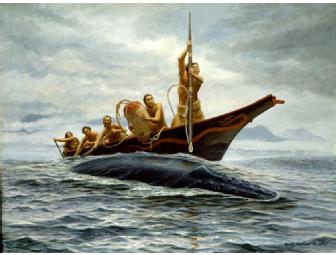THE STRIKE 17 x 22 Giclee Print by Bill Holm

Item Number: 168
Time Left: CLOSED
Description
Giclée print in archival inks on acid- and lignin-free paper
Original painting in acrylic on linen 18” X 24”
Collection of the Canadian Museum of Civilization
Humpback and gray whales, migrating along the outer coasts of Vancouver Island and Washington State’s Olympic Peinisula, were the most prestigious prey of Nuu-chah-nulth and Makah sea hunters, who pursued the whales in cedar canoes in the open Pacific. Whales successfully killed and towed back to the whalers’ village, as well as dead whales that drifted to shore, were important sources of meat, oil, bone, and sinew. But the economic importance of whaling was far overshadowed by its prestige.
Harpooning a whale was an inherited chiefly privilege, and a successful whaler was honored far beyond his own time. Ritual preparation for the hunt was long and arduous, and the loss of a whale was usually attributed to some failure on the part of a crewman to carefully follow all the ceremonial requirements..Even with all care, effort, and skill, the success rate was not high. John Jewitt, describing the Mowachaht chief Maqquina’s whaling in 1803,1804, and 1805, counted 53 days of hunting in which one whale was killed and several lost.
The canoe used in whaling was fairly beamy for its length of about six fathoms (or outstretched arms) in order to accommodate its crew of eight—the harpooner, six paddlers, a steersman—and the whaling gear itself. The heavy yewwood harpoon shaft, up to 14 feet long, the mussel shell-bladed point and its sinew lanyard, up to one hundred fathoms of cedar with line, four inflated floats of hair seal skin, a killing lance, and spare shaft, points and uninflated floats, combined to make a bulky load. Provisions and water were needed, especially if a harpooned whale ran seaward and required a long tow home.
The whaling canoe approached the whale from its left side and at the proper moment, just before the whale dived, the harpooner struck it behind the flipper. As the harpoon struck, the paddlers in turn cast the floats and line overboard and turned the canoe away from the struggling whale. With luck and proper ritual preparation the whale ran toward land. When it had tired enough, the whalers approached again and killed the whale with a lance. Then began the long paddle back to the beach and the butchering. A cut of skin and blubber including the dorsal fin was ceremonially prepared and displayed in the whaler’s house, to honor both the whale and its captor.
The Strike depicts the moment before the whaler casts his harpoon. His quarry, a humpback whale, is about to dive, after having surfaced several times to breathe. The canoe is an early style, with long, forward-thrust bow, less upright than leter models. A Lightning Serpent, the "Harpoon of the Thunderbird," is painted on the hull. The first paddler is preparing to cast overboard his seal skin float, with its red and black ownership designs. A light wind ripples the surface of the long ocean swells. Low clouds and fog partially obscure the Vancouver Island shore.